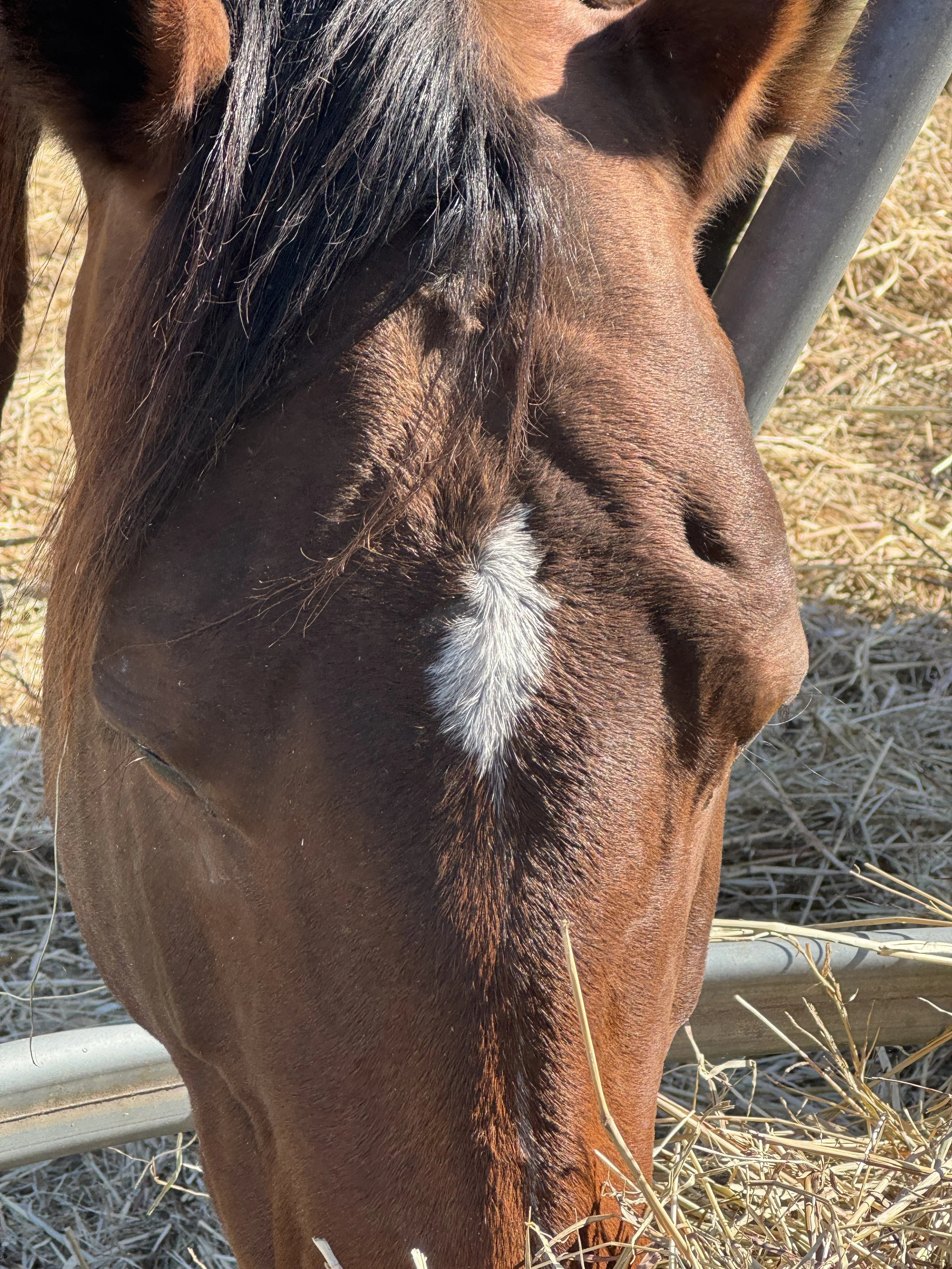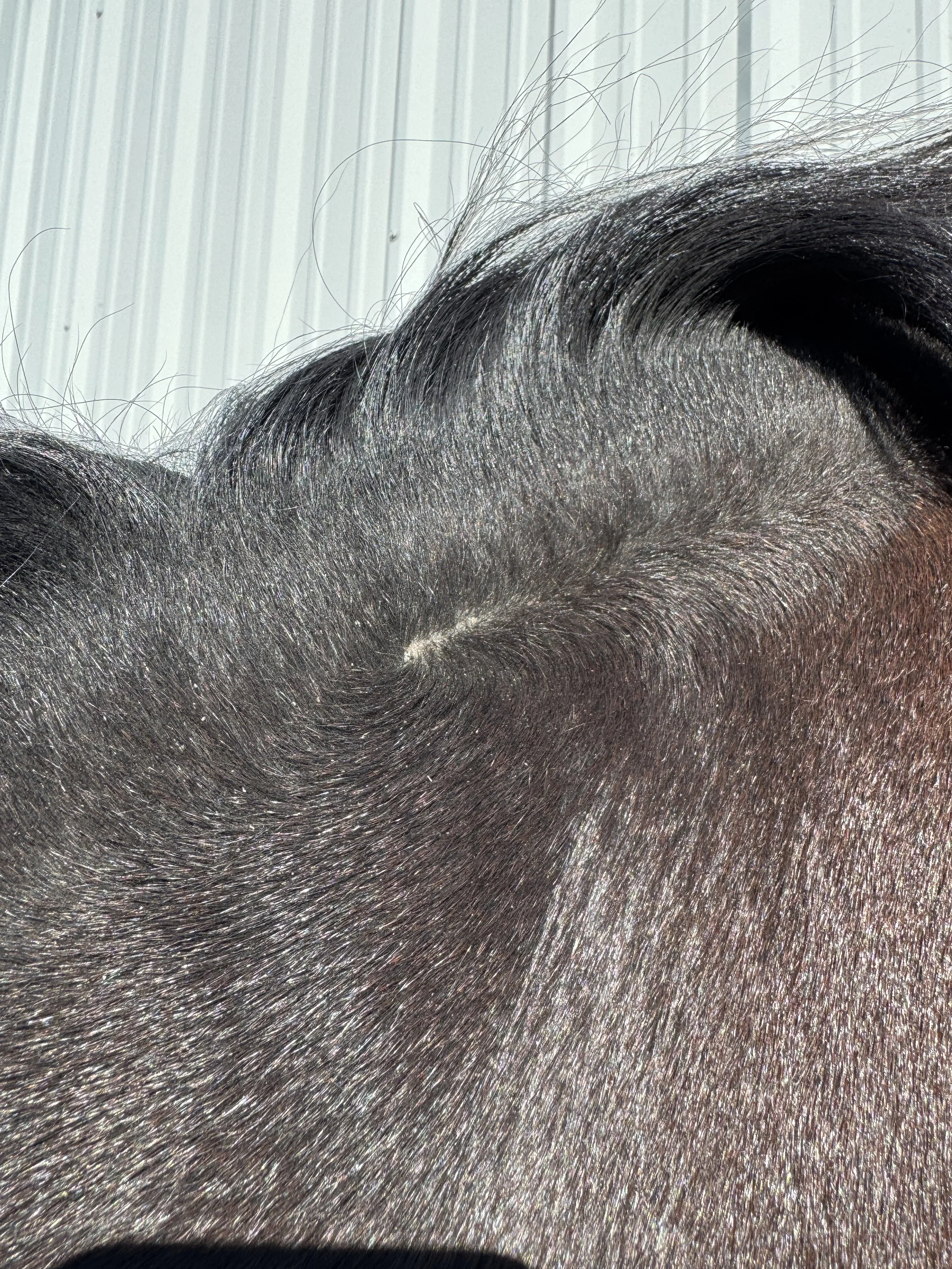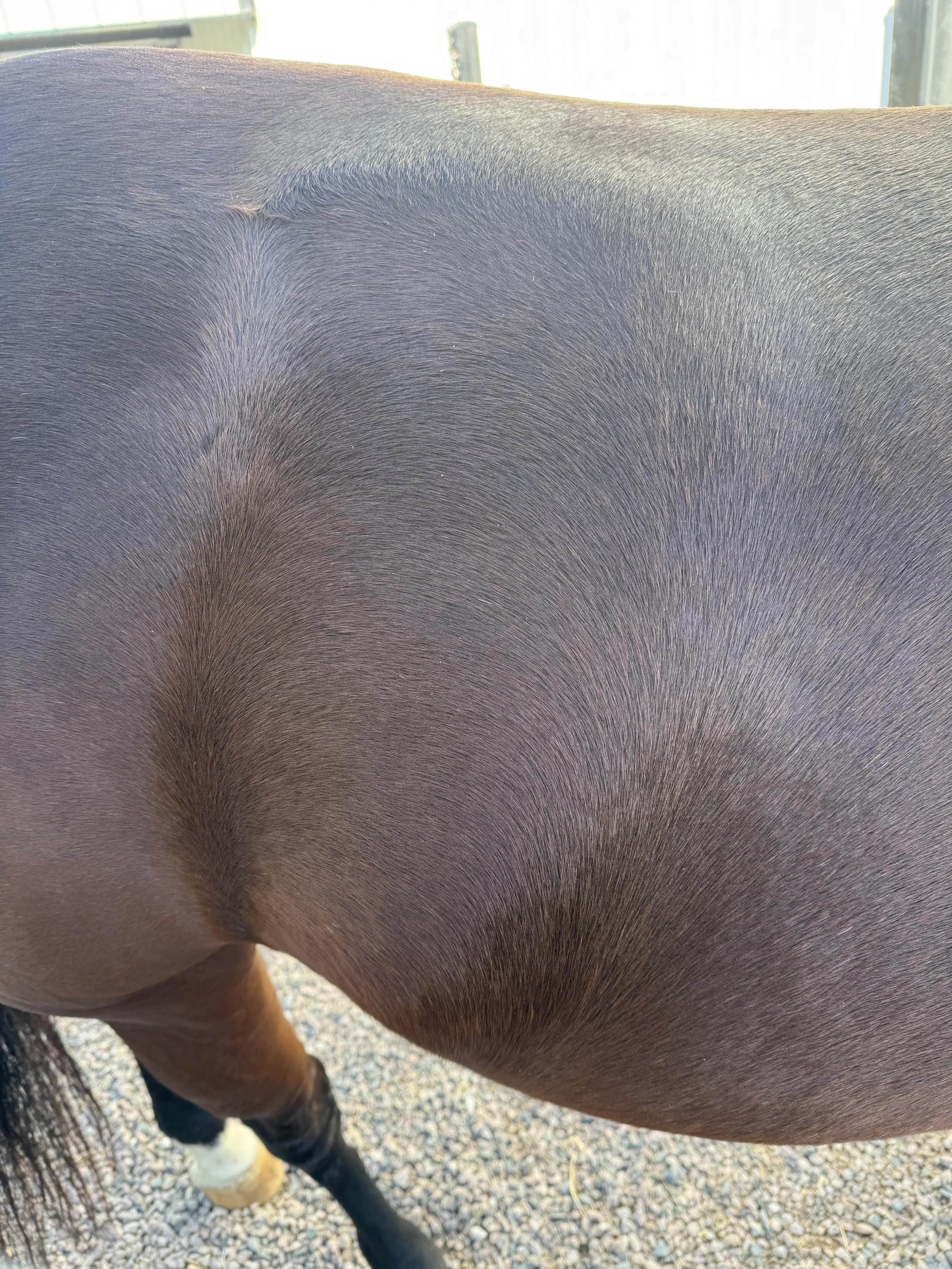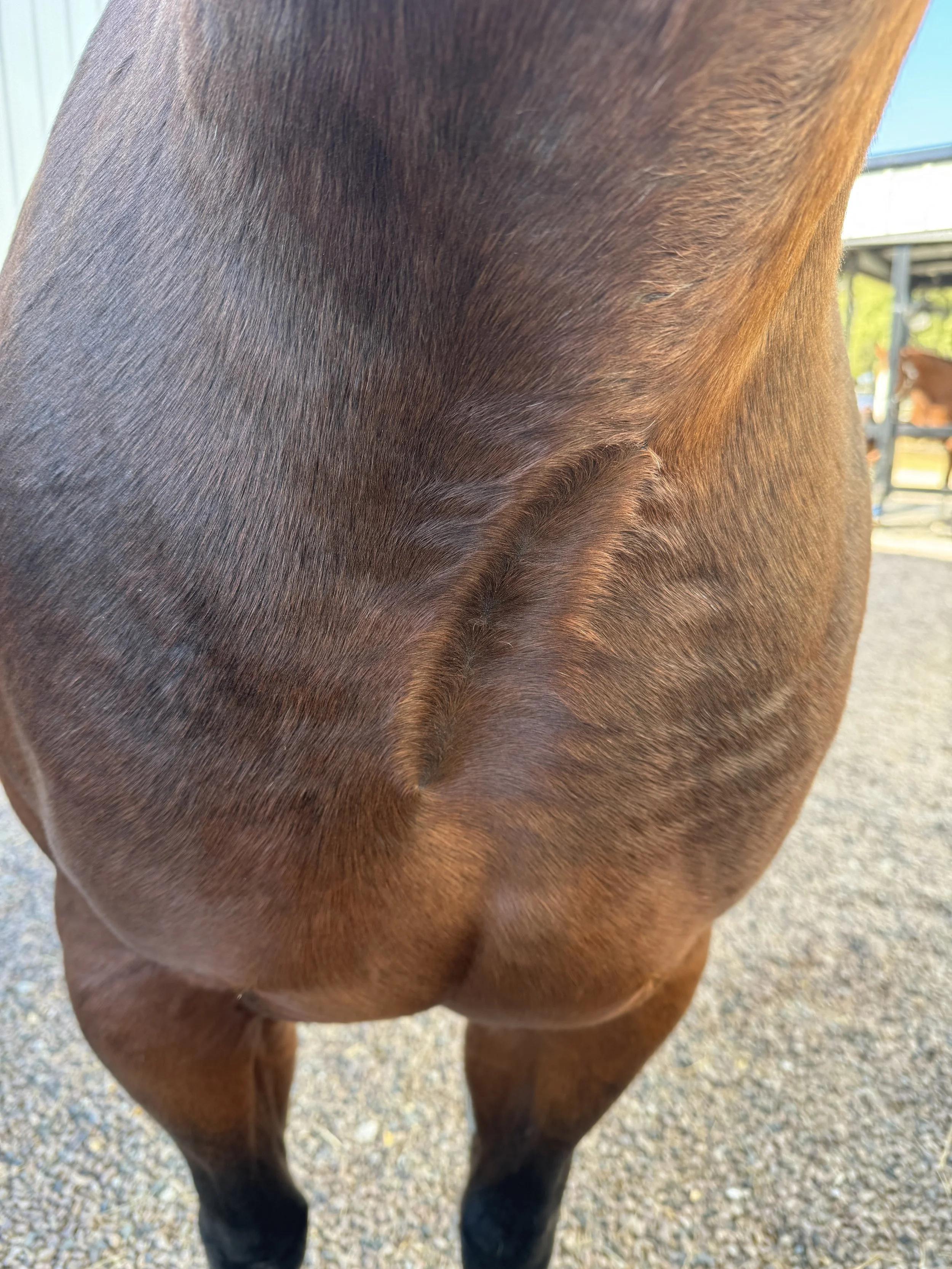November 7, 2025: The Whorl on Bee’s Forehead
Donna (Beemer’s mom) and I were out riding Monday when she mentioned something I’d never really thought much about: the whorls on a horse’s face. Heck, I didn’t even know how to spell it: whirl, whurl, wurl, swurl, swirel. So add that one to your repertoire, Scrabblers. That little comment sent me down the rabbit hole of horse swirls and personality patterns, and by the time I finished reading, I was fascinated. Maybe you will be too.
Can you spot Bee’s Whorl?
Every horse has them, those funny little spirals of hair that twist in their own direction. Bee’s facial whorl sits above her eyes, right at the top of her white blaze. (A blaze is the white stripe that runs down the center of her face, like a perfectly placed racing stripe.) Hers is high and slightly right-of-center (left-of-center looking at the picture), and according to traditional “whorl readers,” that says a lot about her personality.
Apparently, Bee’s whorls have been trying to tell me about her all along. I’m listening now!
🌀 Swirls and Whorls: What a Horse’s Hair Can Tell You
If you’ve ever stood in front of a horse and noticed the little spiral of hair on its forehead, you’ve found what’s called a whorl (or swirl). At first glance, it’s just a quirky patch of hair growing in a different direction, but horse people have been fascinated by them for centuries, believing they reveal everything from temperament to trainability.
What Exactly Is a Whorl?
A whorl is simply a spot where the hair on a horse’s body grows in opposing directions, creating a visible swirl or rosette pattern. They form before birth, while the foal is still developing in the womb, and remain for life. Every horse has them, but their number, size, shape, and placement can vary dramatically.
Common locations include:
The forehead (the most recognized one) ✅
The neck, shoulders, or flanks ✅
Around the eyes, muzzle, or cheeks ❌
Under the jaw, along the belly, or near the girth area ✅
Many horses have a single forehead whorl, but some have two (or more), and that’s where things start to get interesting.
The Old Wisdom: What Whorls Say About Temperament
Before modern genetics, horsemen believed whorls were a window into a horse’s mind. Those theories date back thousands of years, even appearing in Indian, Bedouin, and European horsemanship traditions. While science hasn’t fully proven the link between hair patterns and personality, some studies suggest there might be a connection between prenatal development (including brain and hair follicle formation) and behavior.
Here’s what traditional “whorl readers” say:
Single, centered whorl (between or just above the eyes): Calm, steady, reliable disposition. Easy to train and level-headed, the hallmark of a trustworthy partner.
Whorl high on the forehead: More energetic, alert, or reactive. Quick-thinking, sometimes “forward” or high-spirited. (Ahem, Bee’s is here, and this description fits her perfectly.)
Whorl below the eyes: Quiet, laid-back, even-tempered, sometimes to the point of being lazy.
Two whorls close together: Intelligent, sensitive, and responsive. Horses like this often bond deeply with one rider but can be quick to react.
Two whorls far apart (especially asymmetrical): Independent thinkers, sometimes quirky, unpredictable, or strong-willed.
Vertical (long) whorl: A blend of qualities, awareness, and intelligence balanced with steady energy.
Spirals or whorls tilted to one side: The horse may tend to favor that side physically or mentally (left- or right-brained).
Of course, it’s not an exact science, but longtime horse owners swear the patterns don’t lie.
Bee’s Whorl (and What It Might Say About Her)
Bee has a distinct whorl above her eyes at the top of her blaze. That placement traditionally suggests a horse who’s attentive and tuned in to her surroundings, which is spot-on for her. She’s curious, aware, and ready to move when asked, but she’s not too spooky or unmanageable. Don’t get me wrong, she can spook, but it’s usually more of a skin flinch or a quick “oops” step under saddle.
If you’ve ever noticed how quickly she spots movement or turns her head when something catches her eye, that’s classic “high whorl” behavior: alert but thoughtful.
Beyond the Face: Other Whorls with Meaning
While most people notice forehead whorls, they appear all over the body. Some folklore and modern equine behavioral studies say these can hint at trainability or handedness:
Neck whorls: May correlate with flexibility or stiffness on one side. (Bee has one on the right side of her neck and has no trouble bending her neck all the way to her flanks on both sides. We learned to help keep her flexible by giving treats placed there — a trick from Melinda and Calvin.)
Flank whorls: Sometimes seen in highly athletic horses or those with “big engine” drive from the hindquarters. (Bee’s got some of these too. I haven’t necessarily seen her whole engine, because I’m sure I’d fly off if we ever turned off “training” speed. She did win American Paint Horse Association Worlds in barrels with her prior owner, so I know she’s got serious gas. I just don’t use that pedal much.)
Muzzle and chin whorls: Horses with lower-face whorls are said to be inquisitive and people-oriented — the kind that like to nuzzle pockets for treats.
Chest whorls: Associated with determination and strength.
^^Bee’s neck whorl. Donna also said the length of that line tells us something too — maybe I’ll look into that next week!^^
^^Bee’s flank swirls and whorls.^^
^^Bee’s chest whorl(s).^^
Ancient Bedouins even recorded a horse’s whorl pattern on breeding documents, believing the location and direction (clockwise or counterclockwise) influenced not just behavior but luck.
The Science Side
While traditional readings are more folklore than fact, modern research gives some of it a nod. Studies at the University of Applied Sciences in Vienna and others have shown possible links between facial whorl patterns and laterality (whether a horse is right- or left-eyed dominant) and even emotional reactivity. In short, the whorls might not cause behavior, but they can reflect how a horse’s brain developed before birth.
Genetically, whorls are believed to be heritable traits, which means offspring often inherit similar swirl locations from their parents. That’s why breeders sometimes make note of them in detailed registration or conformation records.
Whorls, Color, and Personality: The Whole Picture
When you pair whorl studies with coat color genetics, conformation, and breed tendencies, you start to see why each horse truly is one of a kind. Bee’s smooth sorrel coat might mark her as a Solid Paint-Bred, but it’s her markings, whorls, and personality that make her unmistakably her.
Next time you’re at the barn, look closely at your horse’s forehead. Notice the direction, height, and shape of that swirl. Then compare it with your barn mates — it’s amazing how often the pattern fits the horse’s personality perfectly.
Fun Facts about Whorls
Every horse has at least one, and no two are identical. They’re as unique as fingerprints.
Some horses have body whorls that form mirror images on each side, often seen as a sign of balance.
Cattle, dogs, and even humans have whorl patterns influenced by prenatal development.
In horses, clockwise vs. counterclockwise growth might correlate with which side of the brain is dominant.
The More You Know (and Notice)
It’s funny how one casual ride conversation can turn into a whole new way of seeing your horse. I’ve brushed Bee’s face a thousand times and never stopped to wonder what that little swirl meant. Now, I can’t unsee it.
The more I learn about whorls, and the incredible mix of science, folklore, and horse sense behind them, the more I appreciate how unique every horse really is. From breed to coat colors and patterns, whorls to whinnies, each one tells a story.
So next time you’re out at a barn, take a closer look at a horse’s face. That tiny swirl of hair might just be whispering something about who they are.
Until next time, keep buzzing!
Christina & Bee 🐝💛





